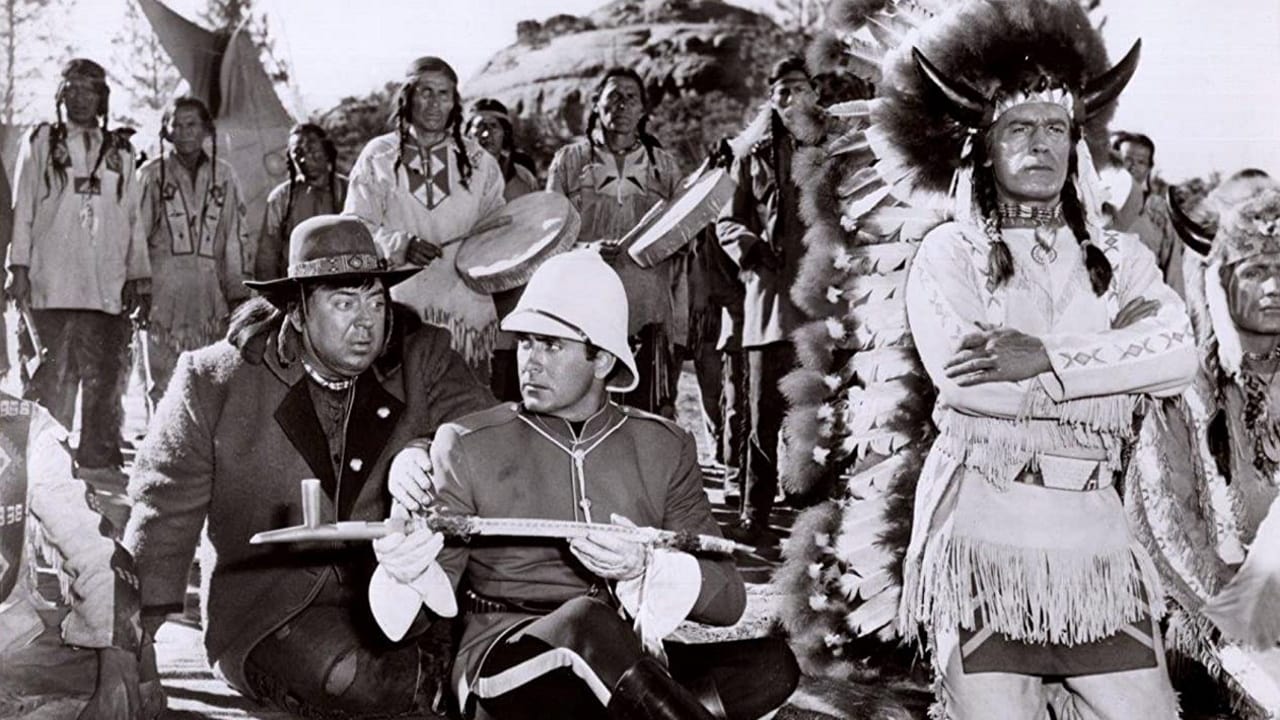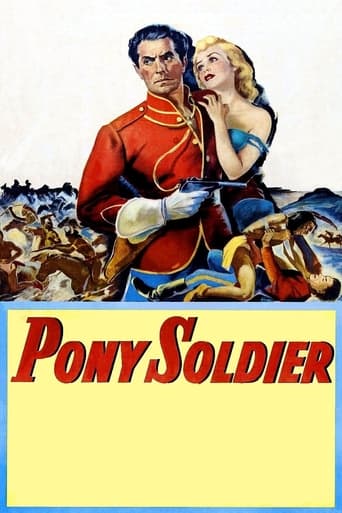

Mediocre and unexceptional western dealing with a tale of the early days of Canadian Mounted Police and their relationships with the Indians . Average Western has Tyrone power as the Mountie on an assignment to the US to stop rebel Indians led by Stuart Randall as Standing Bear and Cameron Mitchell as Konah and their Cree tribes from launching an all out attack . As Tyrone , accompanied by Natayo: Thomas Gómez, has to keep rescuing hostages throughout the movie , as well as battling Cameron Mitchell and help harassed settlers fight Indians .There are White captives to be rescued : Robert Horten , Penny Edwards , too , and building a thrilling final confrontation . Spectacular , though medium budget western , with thrills , fights , go riding , and being mostly shot at an Indian location .Cast is pretty good , it stars Tyrone Power , a fine actor who performed some classic swashbucklers, until his early death in Spain when he was shooting Salomon and Queen of Sheba by King Vidor ; However , he is miscast in a very minor stuff for his usual standards . Costars Penny Edwards as the heroíne in distress who is kidnapped by Indians , she spent several years languishing in Roy Rogers Westerns . Support cast is frankly well ,such as : Cameron Mitchell , and Stuart Randall as two Indian chiefs who are raiding Montana from their Canadian reservation , Robert Horton as a nasty hostage , Thomas Gomez as a fatty scout and uncredited Richard Boone , Earl Holliman and Michael Rennie as narrator . Colorfully and attractively cinematographed in pale but brilliant Technicolor by the professional cameraman Harry Jackson , Universal's ordinary . The movie belongs to Canadian Mountie sub-genre including important titles as 1947 Unconquered by Cecil B DeMille , 1954 Saskatchewan by Raoul Walsh and 1961 Canadians by Burt Kennedy motion picture was regularly directed by Joseph M Newman. He was a prolific assistant director , writer and producer . As a filmmaker he realized a lot of films with no much success , and directing all kinds of genres with penchant for Western , Noir and Gangster movies such as The George Raft story , A Thunder of drums , The lawbreakers, The story of Arnold Rothstein , Tarzan the ape man , The big circus , Fort massacre , Flight to Hong Kong , Kiss of fire , Red skies of Montana , 711 Ocean drive, Vendetta , Outcasts of poker flat , Abandoned , Northwest Rangers , Don't Talk , Women in hiding, among others .
... View MoreIt's 1876. The Cree Indians of Saskatchewan have crossed the US border to hunt buffalo. There is a clash with the US cavalry and Standing Bear leads his Cree back across the border, taking two white hostages. It's the task of Constable Tyrone Power in full RCMP panoply to located the Cree, rescue the hostages, and talk Standing Bear into returning to the reservation, where they will be provided with food and shelter. Standing Bear is a reasonable guy. But he has to contend with Cameron Mitchell as Konah, the young Turk who wants to kill all the white. Likewise, one of the white hostages, a bank robber, would love to kill all the Indians. How do you handle a minority that actually seems to enjoy the prospect of war and killing? It's a perennial problem and culture doesn't seem to count for much.It's an unusual Western in that it deals as much with the issues facing the Cree as it does with the problems facing Tyrone Power. Power is the protagonist, the principled central figure, but the milieu is that of the Cree, and they're no more stereotyped than any other group liable to be found in a typical 1950s feature film.Standing Bear is thoughtful, spiritual, democratic, and a man of his word. But the aggressive Konah is not shown as evil either, just mistaken in his values. Of course, he gets it in the end anyway. There must be a final shoot out in a Western and somebody has to die.The dialog gets a couple of things right. Duncan in Gaelic may very well mean "brown warrior." The Cree and the American Blackfeet actually were at odds with one another. And the talk of "medicine" was real enough -- and still is. I lived with the Blackfeet as an anthropologist and the medicine man has a social status at least equal to that of his Christian counterpart.At the same time, the dialog is stilted and "Indian-like". In the case of Thomas Gomez, as the comic sidekick, it sounds like Charlie Chan. And although the narration refers to the humiliation of the Cree's defeat at the hands of the Long Knives, the Plains Indians didn't really care much about victory or defeat. Like T. E. Lawrence's Arabs, they fought for a while and then went home when they were tired of it.The movie isn't filled with action, and I must say not all of it rings true. It's more suspenseful than thrilling, but the musical score hints at Canada's national anthem and the photography can be luscious. It's enlightening too. Canada is as vast as the US, had all kinds of Indians and still does. Yet it never went through the genocidal Indian Wars that America did. I wonder how come? Did we have more Konahs, on both sides?
... View MoreHollywood's depictions of the Mounted Police and Canada are notorious for playing free and loose with the facts, you won't find much worse than Pony Soldier.The Arizona desert is apparently a suitable substitute for locations in Saskatchewan and Montana. History is rewritten as the Saskatchewan Cree fight a battle with the US Cavalry. The Cree are depicted as child-like simpletons, a desert mirage of a lake and paddle wheeler has them bowing and praying in awe. This piece of blarney is the plot device for Tyrone Power saving the day. I guess when you transplant a northern Indian tribe into the Arizona desert, anything is possible.The dialogue is wooden and clichéd, including the old wheeze "He speaks with forked tongue". The movie would have you believe the Cree burned captives alive. Wrong, but maybe the Arizona Cree did so.Keep an eye out for Power's magical red tunic. Amusing to see him rolling around on the ground and covered in dust, then jumping up with his uniform ready for a parade ground inspection.
... View MoreI'm not sure, but has there ever been a film made with a less than sympathetic treatment of the Royal Canadian Mounted Police? The Mounties have done very well cinema wise and Pony Soldier is not setting any new patterns.It doesn't have to because it's a very entertaining film. The plot has a lot of similarities to Broken Arrow which 20th Century Fox also produced. Tyrone Power is playing Constable Duncan MacDonald, newly arrived at Fort Walsh and sent out on a mission to negotiate a peace with Cree Indians who've left their reserve and tangled with U.S. Cavalry south of the border. On the way back they've taken two white prisoners in a raid and Power is looking to get them back. One is Penny Edwards who catches the eye of Cameron Mitchell and he decides she'd make a good squaw for his little brother. The other is Robert Horton who's an escaped outlaw.So intrepid Mountie Power along with his Indian guide Thomas Gomez go to the camp of the Crees. Gomez is a most reluctant guide, in fact he's kind of blackmailed into making the journey. Thomas Gomez is an underrated and capable actor who deadpans some very funny lines.Two others in the cast really make this work. Little Anthony Numkena plays the Cree Indian boy who Power adopts and that turns out to be a great negotiating technique. But their affection is genuine and the scenes between Power and Numkena are some of the best in the film.Stuart Randall plays the Cree Chief Standing Bear. His portrayal is very similar to Jeff Chandler's more heralded portrayal of Cochise in Broken Arrow. In fact the Indians are not stereotyped, they are three dimensional characters here. Randall does a fine job as Standing Bear, negotiating with Power and having to contend with militants in his own camp led by Cameron Mitchell. Since Jeff Chandler had already broken the same ground with Cochise, Randall's performance has been overlooked, unfortunately so for him.Tyrone Power is a whole cloth hero here and does a fine job. One of the things that Americans don't appreciate is that the Mounties were there in large measure to protect the native Indians from white depredation. Canadians have always loved contrasting that to how the U.S. Cavalry treated the native population. Our cavalry was there on the settler's behalf. The contrast is certainly a matter of historical record, but I wonder if Canada had seen the immigration westward that America did, would their Mounties have been more like our blue coats.
... View More